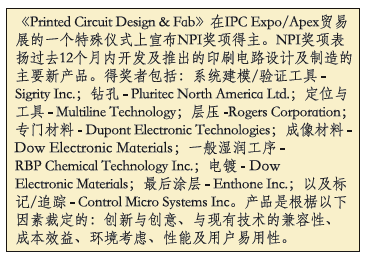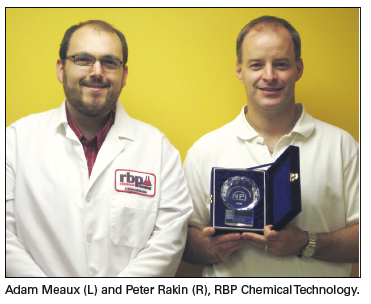
Last, but not least, the final installment of interviews with the 2009 NPI Award winners.
Millions of dollars are spent each year on basic research to improve products and processes for PCB fabrication. R&D, however, is not immune to economic influences. Battelle, a nonprofit independent research and development organization, reported that industries, including electronic measuring and testing instruments and other general electronics sectors, will see a decline in R&D funding for 2009. In a report published in February 2009, Battelle1 cited the following developing trends in R&D spending and practices that are influencing funding decisions: restructuring of major corporate R&D approaches, growth in offshore outsourcing of R&D and a shift in federal priorities [read: funding]. The central theme of many R&D programs for 2009 will feature the new triple-e mantra: energy, environment and economy.
As we look at this final installment of the NPI Award coverage for 2009, we will review products and R&D teams from two PCB fab equipment suppliers and a chemical supplier. We talked with Michael Angelo, president of Multiline, Pietro Zulli, applications engineer for Pluritec and Rob Colman, managing director – Asia for RBP Chemical Technology.
NPI Award Winner, MultilineCategory: Registration and Tooling
Product: Multiworx
PCD&F: How did the idea for the product come about?
Multiline: All Multiline equipment has the ability to to measure and to tool artwork, innerlayers or laminated panels. Our customers have all tried on their own to collect this measurement data and use it upstream to make front-end corrections and eliminate panels that are out of tolerance. We recognized the need to put this data in a usable format, tied to a database and stackup engine, and to integrate it to CAM so all our customers could use it as a method of achieving “predictive registration” when tooling new part numbers.
PCD&F: Who was involved in the product’s research and development effort?
Multiline: The X-ray machine and the initial software were developed by Multiline engineering, under the supervision of Ron Ferina. Ferina has been the engineering manager at Multiline for over 20 years and has been responsible for Multiline’s product development including X-ray products, post etch punching, lamination layup and automatic phototool registration equipment for outer layers and solder mask applications.
The enhanced software was provided through our partnership with Direct Logix and their staff including Leigh Eichel, vice president of product marketing and sales. Eichel has over 20 years of experience developing software systems in the PCB fabrication and engineering areas for several companies.
PCD&F: Why is this product important to the PCB industry?
Multiline: Multiworx provides the PCB manufacturer an opportunity to analyze and to fix the registration before the production process. Multiworx, in conjunction with the XRT X-ray machine, provides current information, as well as accumulated past history, for real-time scaling. This is a real opportunity for the PCB industry to improve registration and decrease scrap rate significantly. Decreased scrap rates drive direct and immediate profit increases.
PCD&F: What are the product’s key benefits?
Multiline: Multiworx and the XRT X-ray machine will provide the PCB fabricator the first predictive registration system. This has the benefit of reducing scrap significantly and improving registration. It also turns the X-ray post process drill into a measuring machine capable of accumulating registration data and provides graphic representations of layer-by-layer shifts in a finished multilayer. In the future, it can also be tied to the other registration processes of artwork and post-etch punching.
NPI Award Winner, Pluritec Inc.Category: Drilling
Product: Inspecta HPL
PCD&F: How did the idea for the product come about?
Pluritec: Customers had asked to have the possibility to internally inspect multilayer panels in all ability regions.
Since the presence of a sophisticated multilayer configuration (e.g. some areas of the panel where the distribution of the copper is not available as in other areas), the thermal deformation of the circuits (after the lamination process) is not linear as in many conventional multilayer panels.
In addition to the need to inspect the panels between each multilayer, there were also requests for direct drilling (complete part-program) of multilayer panels on the X-ray machine. In a few words, the need was for a drilling machine with the integration of the X-ray system.
This equipment, in fact, had to be the right tool for particular circuits having a very critical annular ring.
Starting from the above specification, Pluritec started to design a machine with a dedicated structure, allowing the X-ray sources to move and to inspect all working areas of the panels to be processed.
From the CNC side, a lot of effort has been made in order to integrate all the software of a sophisticated X-ray system with the software of a drill/routing machine.
PCD&F: Who was on the R&D team?
Pluritec: Andrea Gamerro, R&D manager, is considered the “father” of the Pluritec “PCB Control” that is currently installed on the Inspecta HPL model. The PCB Control provides the integration of drilling/routing software with the X-ray vision software. As applications manager, I played a role, too. I was responsible for the interface between our customer needs and the Pluritec technical departments to make sure that customers' requirements were met.
PCD&F: Why is this product important to the PCB industry?
Pluritec: This product is important because, in addition to the standard and innovative functions of an X-ray machine, it offers the possibility to directly drill very complex multilayer panels by internally inspecting all the critical areas in order to apply the relevant individual compensation.
PCD&F: Please provide a summary of the product benefits.
Pluritec: It can be used like a standard X-ray optimizer by using innovative and useful functions. Thanks to the dedicated machine structure, a multilayer panel can be inspected in almost all areas, in order to get the data needed to correct/modify the artwork. It can directly drill a multilayer panel in one step for the best optimization and drilling accuracy. Machine flexibility is a big factor. The Inspecta HPL model has many different configurations available including; drilling, routing and X-ray.
NPI Award Winner, RBP Chemical TechnologyCategory: General Wet Process
Product: Microstrip One
 PCD&F:
PCD&F: How did the idea for the product come about?
RBP Chemical: PCB fabricators and dry film suppliers sought a stripper capable of removing the new high-resolution, but tenacious, photo resists.
PCD&F: Who are the key researchers involved in the product’s research and development effort?
RBP Chemical: Peter Rankin, director of technology development. He oversaw the creation of both Microstrip ONE and FoamFREE ONE, the two new products released this year. Rankin has a Ph.D. from the University of Wisconsin at Madison and a B.S. from Cornell University, both in chemical engineering.
Adam Meaux, product development chemist, has been involved with several R&D initiatives focusing primarily on product development for the electronics business sector of RBP Chemical. Meaux was the chief researcher responsible for the creation of the product. Rankin and Meaux are seen in FIGURE 1.
Dr. Gonzalo Urrutia Desmaison, organic chemistry and PCB technology consultant, provided expertise on the development of improved PCB processing chemicals.
PCD&F: Why is this product importan?
RBP Chemical: This product can improve throughput and first pass yields (hence total operating costs) in a high-resolution, fine-line application.
PCD&F: Summarize the product’s benefits.
RBP Chemical: The product results in the complete removal of the most tenacious resists from trapped or overplated areas, strips up to 4 mil work in a single pass, reduces scrap and rework, supports green initiatives.
PCD&FREFERENCE
2009 Global R&D Funding Forecast, Battelle Memorial Institute in cooperation with
R&D magazine.
www.battelle.org/news/pdfs/2009RDFundingfinalreport.pdf.
Kathy Nargi-Toth is editor for
Printed Circuit Design & Fab;
This email address is being protected from spambots. You need JavaScript enabled to view it..















